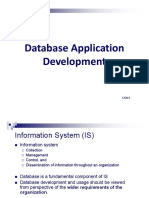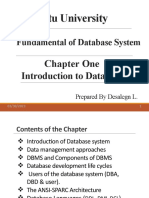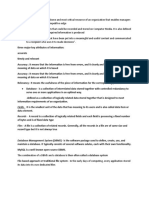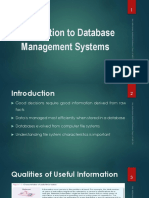0 ratings0% found this document useful (0 votes)
14 viewsTopic 1 - Introduction To Database Systems
The document provides an introduction to database systems, including the components and architecture of a database system as well as the database development life cycle. It discusses the conceptual, logical, and physical design of databases and data independence.
Uploaded by
miragelimited91Copyright
© © All Rights Reserved
Available Formats
Download as PPT, PDF, TXT or read online on Scribd
0 ratings0% found this document useful (0 votes)
14 viewsTopic 1 - Introduction To Database Systems
The document provides an introduction to database systems, including the components and architecture of a database system as well as the database development life cycle. It discusses the conceptual, logical, and physical design of databases and data independence.
Uploaded by
miragelimited91Copyright
© © All Rights Reserved
Available Formats
Download as PPT, PDF, TXT or read online on Scribd
You are on page 1/ 20
Introduction to
Database Systems
Intro to Database Systems 1
Database and Database System
A database is a shared collection of
logically related data designed to meet the
information needs of an organization.
Components of a Database Systems
Database
Hardware
Software - DBMS
Procedures
Users
Intro to Database Systems 2
Database
The data in the database will be expected
to be both integrated and shared
particularly on multi-user systems
Integration - The database may be thought
of as a unification of several otherwise
distinct files, with any redundancy among
these files eliminated
Shared - individual pieces of data in the
database may be shared among several
different users
Intro to Database Systems 3
Hardware
These are secondary storage on which the
database physically resides, together with the
associated I/O devices, device controllers etc.
Procedures
Instruction and rules that govern design and
use of databases e.g. starting and stopping
db, making backups, handling failures.
Intro to Database Systems 4
Users - Roles
Database Designers - designs conceptual and
logical database
Application Developers - writes application
programs that use the database
Data and Database Administrator
End - user - interacts with the system from an
on-line terminal by using Query Languages
etc.
Intro to Database Systems 5
Data & Database Administration
Data Administrator – a business manager
responsible for controlling the overall
corporate data resources
Database Administrator (DBA) - a technical
person responsible for development of the
total system
Intro to Database Systems 6
Advantages
Control of data Improved data
redundancy accessibility and
Data consistency responsiveness
Multipurpose use of Increased productivity
data
Improved maintenance
Sharing of data, through data
Enforcement of independence
standards
Increased concurrency
Economy of scale
Balance conflicting user
Improved backup and
requirement recovery services.
Intro to Database Systems 7
Disadvantages
Complexity
Size
Cost of DBMS
Additional hardware costs
Cost of conversion
Intro to Database Systems 8
Database Architecture
External Level
Application 1 Application 2 Application 3
Logical Data
Independence
Conceptual
Level
DBMS
Physical Data
Independence
Internal Level Database
Intro to Database Systems 9
Database Architecture
External Level – concerned with the way
users perceive the database
Conceptual Level – concerned with
abstract representation of the database in
its entirety
Internal Level – concerned with the way
data is actually stored
Intro to Database Systems 10
Data Independence
Logical Data Independence – users and user
programs are independent of logical structure
of the database
Physical Data Independence – the separation
of structural information about the data from
the programs that manipulate and use the
data i.e. the immunity of application
programs to changes in the storage structure
and access strategy
Intro to Database Systems 11
Db Development Life Cycle
Database planning
System definition
Requirement collection and analysis
Database design
DBMS selection
Application design
Prototyping
Implementation
Data conversion and loading
Testing
Operational maintenance
Intro to Database Systems 12
Database Design
Conceptual database design - the process of
constructing a model of the information used
in an organization, independent of all
physical considerations
Step 1 Build local conceptual data model for
each user view
Intro to Database Systems 13
Database Design
Logical database design for the relational
model - the process of constructing a model
of the info used in an organization based on a
specific data model, but independent of a
particular DBMS and other physical
considerations
Step 2 Build and validate local data model for
each user view
Step 3 Build and validate global logical data
model
Intro to Database Systems 14
Database Design
• Physical database design for relational
databases - the process of producing a
description of the implementation of the
database on secondary storage.
Step 4 Translate global data model for target
DBMS
Step 5 Design physical representation
Step 6 Design security mechanisms
Step 7 Monitor and tune the operational system
Intro to Database Systems 15
Conceptual Database Design
Step 1 Build local conceptual data model for
each user view
Identify entity types
Identify relationship types
Identify and associate attributes with entity or relationship
Determine attributes domains
Determine candidate and primary key attributes
Specialize/generalize entity types (optional step)
Draw Entity-Relationship diagram
Review local conceptual data model with user
Intro to Database Systems 16
Logical Database Design for the
Relational Model
Step 2 Build and validate local data model for
each user view
Map local conceptual data model to local logical
data model
Derive relations from local logical data model
Validate model using normalization
Validate model against user transactions
Draw Entity-Relationship diagram
Define integrity constraints
Review local logical data model with user
Intro to Database Systems 17
Logical Database Design for the
Relational Model
Step 3 Build and validate global logical data
model
Merge local logical data models into global model
Validate global data model
Check for future growth
Draw final Entity-Relationship diagram
Review global logical data model with users
Intro to Database Systems 18
Physical Database Design for
Relational Databases
Step 4 Translate global data model for target DBMS
Design base relations
Design enterprise constraints for target DBMS
Step 5 Design physical representation
Analyze transactions
Choose file organizations
Choose secondary indexes
Consider the introduction of controlled redundancy
Estimate disk space requirements
Intro to Database Systems 19
Physical Database Design for
Relational Databases
Step 6 Design security mechanisms
Design user views
Design access rules
Step 7 Monitor and tune the operational system
Intro to Database Systems 20
You might also like
- Hourglass Workout Program by Luisagiuliet 276% (21)Hourglass Workout Program by Luisagiuliet 251 pages
- The Hold Me Tight Workbook - Dr. Sue Johnson100% (16)The Hold Me Tight Workbook - Dr. Sue Johnson187 pages
- Read People Like A Book by Patrick King-Edited62% (66)Read People Like A Book by Patrick King-Edited12 pages
- Livingood, Blake - Livingood Daily Your 21-Day Guide To Experience Real Health77% (13)Livingood, Blake - Livingood Daily Your 21-Day Guide To Experience Real Health260 pages
- COSMIC CONSCIOUSNESS OF HUMANITY - PROBLEMS OF NEW COSMOGONY (V.P.Kaznacheev,. Л. V. Trofimov.)94% (212)COSMIC CONSCIOUSNESS OF HUMANITY - PROBLEMS OF NEW COSMOGONY (V.P.Kaznacheev,. Л. V. Trofimov.)212 pages
- Donald Trump & Jeffrey Epstein Rape Lawsuit and Affidavits83% (1016)Donald Trump & Jeffrey Epstein Rape Lawsuit and Affidavits13 pages
- 1.1 Fundamentals of Database Systems - Solutions PDF63% (8)1.1 Fundamentals of Database Systems - Solutions PDF721 pages
- The 36 Questions That Lead To Love - The New York Times94% (34)The 36 Questions That Lead To Love - The New York Times3 pages
- The 36 Questions That Lead To Love - The New York Times95% (21)The 36 Questions That Lead To Love - The New York Times3 pages
- Jeffrey Epstein39s Little Black Book Unredacted PDF75% (12)Jeffrey Epstein39s Little Black Book Unredacted PDF95 pages
- The 4 Hour Workweek, Expanded and Updated by Timothy Ferriss - Excerpt23% (954)The 4 Hour Workweek, Expanded and Updated by Timothy Ferriss - Excerpt38 pages
- Lecture 3 - History of Database, Types of Databases, Components of DBMSNo ratings yetLecture 3 - History of Database, Types of Databases, Components of DBMS42 pages
- Mettu University: Fundamental of Database SystemNo ratings yetMettu University: Fundamental of Database System30 pages
- 4.3 Introduction To Database ManagementNo ratings yet4.3 Introduction To Database Management14 pages
- Database Systems Concepts: Introduction To DatabasesNo ratings yetDatabase Systems Concepts: Introduction To Databases30 pages
- PART 1 - The Database Environment and Development ProcessNo ratings yetPART 1 - The Database Environment and Development Process34 pages
- Security-Part-II-Auditing-Database-SystemsNo ratings yetSecurity-Part-II-Auditing-Database-Systems11 pages
- Instructor: Tinsae D. (MSC.) : Cs-224 - Fundamentals of Database SystemNo ratings yetInstructor: Tinsae D. (MSC.) : Cs-224 - Fundamentals of Database System28 pages
- Lecture 1 - Introduction To DB AND DB EnvironmentNo ratings yetLecture 1 - Introduction To DB AND DB Environment40 pages
- STID3014 - Chapter1 - Introduction To DatabaseNo ratings yetSTID3014 - Chapter1 - Introduction To Database92 pages
- "Database Systems": Book: Modern Database ManagementNo ratings yet"Database Systems": Book: Modern Database Management35 pages
- Unit 6 Database Management Systems: StructureNo ratings yetUnit 6 Database Management Systems: Structure25 pages
- Overview of Physical Database Design MethodologyNo ratings yetOverview of Physical Database Design Methodology5 pages
- Database Systems and Data Models: Course:DDBNo ratings yetDatabase Systems and Data Models: Course:DDB23 pages
- Chapter 1: Introduction Database Management System (DBMS)No ratings yetChapter 1: Introduction Database Management System (DBMS)6 pages
- BVoc-Software-02Sem-DikshaSinghal-DATABASE MANAGEMENT SYSTEMNo ratings yetBVoc-Software-02Sem-DikshaSinghal-DATABASE MANAGEMENT SYSTEM78 pages
- Chapter 1- Introduction to Database SystemsNo ratings yetChapter 1- Introduction to Database Systems46 pages
- THE SQL LANGUAGE: Master Database Management and Unlock the Power of Data (2024 Beginner's Guide)From EverandTHE SQL LANGUAGE: Master Database Management and Unlock the Power of Data (2024 Beginner's Guide)No ratings yet
- Loop Through An Array in JavaScript - Stack OverflowNo ratings yetLoop Through An Array in JavaScript - Stack Overflow44 pages
- Sophos Central Device Encryption: Administrator GuideNo ratings yetSophos Central Device Encryption: Administrator Guide26 pages
- Unit - 2 Information Technology and Business100% (1)Unit - 2 Information Technology and Business22 pages
- Alfresco Summit 2014 - London - Alfresco BatchProcessor and Bulk Import ToolNo ratings yetAlfresco Summit 2014 - London - Alfresco BatchProcessor and Bulk Import Tool38 pages
- Alex Casalboni Advanced Serverless Architectural Patterns On AWSNo ratings yetAlex Casalboni Advanced Serverless Architectural Patterns On AWS48 pages
- Balaji S - Resume - Software Automation Test EngineerNo ratings yetBalaji S - Resume - Software Automation Test Engineer4 pages
- EthioRobot - Advanced AI Language Model Customized Specifically For Ethiopia100% (1)EthioRobot - Advanced AI Language Model Customized Specifically For Ethiopia1 page
- Implementasi Building Information Modeling Direktorat Preservasi Jalan Dan Jembatan Wilayah II - Jeffry Daud Barrung - Icha GianiNo ratings yetImplementasi Building Information Modeling Direktorat Preservasi Jalan Dan Jembatan Wilayah II - Jeffry Daud Barrung - Icha Giani12 pages
- Prevent Unexpected Charges With Azure Billing and Cost ManagementNo ratings yetPrevent Unexpected Charges With Azure Billing and Cost Management14 pages
- University of Cambridge International Examinations General Certificate of Education Advanced LevelNo ratings yetUniversity of Cambridge International Examinations General Certificate of Education Advanced Level16 pages
- CS2255 DATABASE MANAGEMENT SYSTEMS (2marks and 16 Marks) Unit-I Part-ANo ratings yetCS2255 DATABASE MANAGEMENT SYSTEMS (2marks and 16 Marks) Unit-I Part-A32 pages
- 6) a.PGP Message Generation and ReceptionNo ratings yet6) a.PGP Message Generation and Reception4 pages
- Livingood, Blake - Livingood Daily Your 21-Day Guide To Experience Real HealthLivingood, Blake - Livingood Daily Your 21-Day Guide To Experience Real Health
- COSMIC CONSCIOUSNESS OF HUMANITY - PROBLEMS OF NEW COSMOGONY (V.P.Kaznacheev,. Л. V. Trofimov.)COSMIC CONSCIOUSNESS OF HUMANITY - PROBLEMS OF NEW COSMOGONY (V.P.Kaznacheev,. Л. V. Trofimov.)
- Donald Trump & Jeffrey Epstein Rape Lawsuit and AffidavitsDonald Trump & Jeffrey Epstein Rape Lawsuit and Affidavits
- 1.1 Fundamentals of Database Systems - Solutions PDF1.1 Fundamentals of Database Systems - Solutions PDF
- The 36 Questions That Lead To Love - The New York TimesThe 36 Questions That Lead To Love - The New York Times
- The 36 Questions That Lead To Love - The New York TimesThe 36 Questions That Lead To Love - The New York Times
- Jeffrey Epstein39s Little Black Book Unredacted PDFJeffrey Epstein39s Little Black Book Unredacted PDF
- The 4 Hour Workweek, Expanded and Updated by Timothy Ferriss - ExcerptThe 4 Hour Workweek, Expanded and Updated by Timothy Ferriss - Excerpt
- Lecture 3 - History of Database, Types of Databases, Components of DBMSLecture 3 - History of Database, Types of Databases, Components of DBMS
- Database Systems Concepts: Introduction To DatabasesDatabase Systems Concepts: Introduction To Databases
- PART 1 - The Database Environment and Development ProcessPART 1 - The Database Environment and Development Process
- Instructor: Tinsae D. (MSC.) : Cs-224 - Fundamentals of Database SystemInstructor: Tinsae D. (MSC.) : Cs-224 - Fundamentals of Database System
- "Database Systems": Book: Modern Database Management"Database Systems": Book: Modern Database Management
- Chapter 1: Introduction Database Management System (DBMS)Chapter 1: Introduction Database Management System (DBMS)
- BVoc-Software-02Sem-DikshaSinghal-DATABASE MANAGEMENT SYSTEMBVoc-Software-02Sem-DikshaSinghal-DATABASE MANAGEMENT SYSTEM
- THE SQL LANGUAGE: Master Database Management and Unlock the Power of Data (2024 Beginner's Guide)From EverandTHE SQL LANGUAGE: Master Database Management and Unlock the Power of Data (2024 Beginner's Guide)
- Loop Through An Array in JavaScript - Stack OverflowLoop Through An Array in JavaScript - Stack Overflow
- Sophos Central Device Encryption: Administrator GuideSophos Central Device Encryption: Administrator Guide
- Alfresco Summit 2014 - London - Alfresco BatchProcessor and Bulk Import ToolAlfresco Summit 2014 - London - Alfresco BatchProcessor and Bulk Import Tool
- Alex Casalboni Advanced Serverless Architectural Patterns On AWSAlex Casalboni Advanced Serverless Architectural Patterns On AWS
- Balaji S - Resume - Software Automation Test EngineerBalaji S - Resume - Software Automation Test Engineer
- EthioRobot - Advanced AI Language Model Customized Specifically For EthiopiaEthioRobot - Advanced AI Language Model Customized Specifically For Ethiopia
- Implementasi Building Information Modeling Direktorat Preservasi Jalan Dan Jembatan Wilayah II - Jeffry Daud Barrung - Icha GianiImplementasi Building Information Modeling Direktorat Preservasi Jalan Dan Jembatan Wilayah II - Jeffry Daud Barrung - Icha Giani
- Prevent Unexpected Charges With Azure Billing and Cost ManagementPrevent Unexpected Charges With Azure Billing and Cost Management
- University of Cambridge International Examinations General Certificate of Education Advanced LevelUniversity of Cambridge International Examinations General Certificate of Education Advanced Level
- CS2255 DATABASE MANAGEMENT SYSTEMS (2marks and 16 Marks) Unit-I Part-ACS2255 DATABASE MANAGEMENT SYSTEMS (2marks and 16 Marks) Unit-I Part-A























































































































